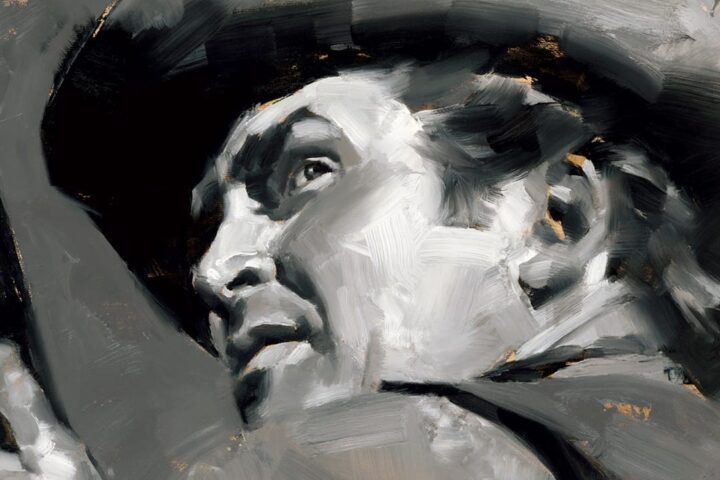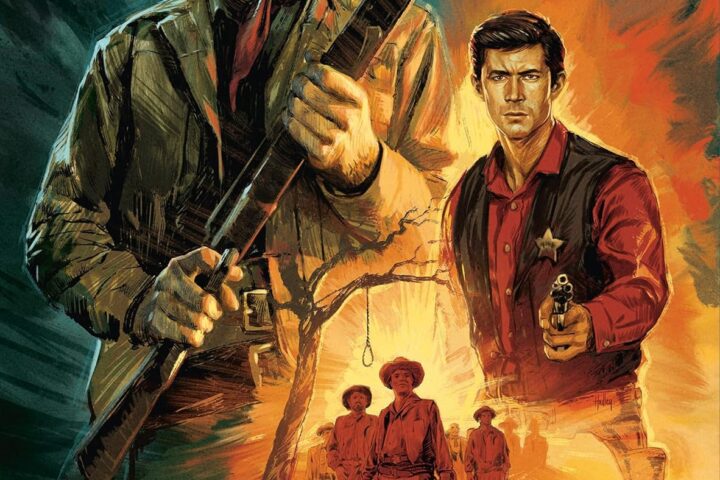Within the same broad outline as Jean Renoir’s La Chienne, Fritz Lang’s Scarlet Street strikes many notes to emphasize the emasculation of Christopher “Chris” Cross (Edgar G. Robinson): at a dinner in his honor, the lowly bank cashier sees his boss (Russell Hicks) rush through a ceremonial toast to make time with his mistress; in his own home he’s obligated to indulge his unwelcome hobby of picture painting in the bathroom; and there’s a bit of business with a frilly smock he puts on to do the dishes.
Against the grain of what we might assume about put-upon little guys in movies and the way they lash out, Lang only dwells on the tableaux of Chris eunuchized doldrums to make one almost invisible moment work—when, over drinks with Katherine “Kitty” March (Joan Bennett), Chris doesn’t really correct her when she makes the fateful assumption that he’s some kind of big-shot famous painter.
Scarlet Street is often twinned with Lang’s The Woman in the Window from the previous year. Scarlet Street is often ranked a little higher in the greater survey of Lang’s filmography, but the earlier film, which also stars Robinson, Bennett, and Dan Duryea, is distinguished by being perched on the precipice of Lang’s descent into the emptier, increasingly nihilistic exercises in genre that would populate his later career. Paradoxically, since The Woman in the Window speaks many of its hypotheses (moral culpability, the privilege of adventure against the advance of age) aloud in dialogue, and Scarlet Street leaves a great deal unsaid, the latter seems, at times, a little too emphatic in pushing Robinson’s disgraced sucker into his purgatory of wandering and self-flagellation. On a similar note, Kitty and Duryea’s rangy pimp Johnny Prince are two-bit villains who seem a little too cartoonish in their callousness. (In the most enjoyable part of Scarlet Street, Duryea tries to learn the ropes of the art racket and does all right.)
Pre-Code Hollywood would have been essentially meaningless to Lang, who, by the time the boom of the Hays Code was brought down on that decadent California town, had fled Nazi Germany to France, to remake Frank Borzage’s Liliom. Even if he had worked at Paramount or Warner alongside William Wellman and Roy Del Ruth during the early-talkie years, it’s hard to imagine Lang would have been much interested in the sexual and class-warfare frankness we tend to associate with that era. Even as his American period saw him work in several popular genres (western, espionage adventure, film noir, war), his preoccupation with fate held dominion over all. In his images and his storytelling, Lang drew together masses of intersecting lines, steel cables that pulled his characters to their doom or their reward.
Such is the overarching structure of Scarlet Street. Renoir and Lang shared an interest in watching the human animal in its natural habitat, while underlining, whenever possible, the elaborate mechanics that governed their interactions, their movement through society, and the changes they underwent across epochal time. But there are essential differences between them. Renoir, during his first celebrated period of the early and middle 1930s, was quite comfortable with the jovial profanity of Michel Simon’s layabouts, as well as the pre-Method fury of Jean Gabin’s crumpled heroes. On the other hand, Lang’s photographic precision indicated that he was more concerned with pivotal dramatic moments, the lightning crashes that, even if they might be forgotten (as Chris’s first run-in with Johnny Prince is quickly put out of the film’s mind), tend to signal a sea change in the lives of all concerned.
Image/Sound
It was a long journey for Fritz Lang’s Scarlet Street from the doldrums of crummy, public domain-sourced DVDs to Kino’s flawed yet revelatory 2012 Blu-ray, which was sourced from a 35mm negative preserved by the Library of Congress. While signs of scratching are still apparent on Kino’s 4K transfer, this release marks another big jump forward for Scarlet Street on home video in terms of image quality, depth, and contrast ratio. Sourced from a new HDR master from a 35mm nitrate print, this transfer features blacks that are as dark as the heart of Joan Bennett’s femme fatale, while depth and detail are remarkable in even the darkest of nighttime sequences. As for the audio, it has a resounding depth, particularly when it comes to Hans J. Salter’s moody score, while the dialogue is nice and crisp.
Extras
In addition to porting over David Kalat’s commentary from its 2012 Blu-ray, Kino has included a newly recorded commentary track with film historian Imogen Sara Smith, who provides expert analysis of the film’s narrative and style. She breaks down numerous scenes, exploring the main characters’ psychology and placing them, and various elements of the film, within the larger context of classic noirs. It’s a wonderfully specific and entertaining discussion that nicely complements Kalat’s broader overview of Lang’s cinema as a whole.
Overall
Kino’s 4K upgrade to one of Fritz Lang’s most lauded American works offers what is easily the best A/V quality of the film to date and a pair of illuminating audio commentaries.
Since 2001, we've brought you uncompromising, candid takes on the world of film, music, television, video games, theater, and more. Independently owned and operated publications like Slant have been hit hard in recent years, but we’re committed to keeping our content free and accessible—meaning no paywalls or fees.
If you like what we do, please consider subscribing to our Patreon or making a donation.


